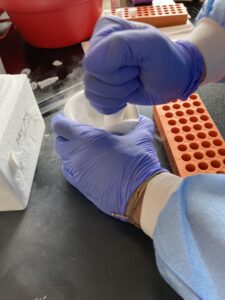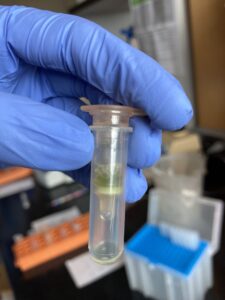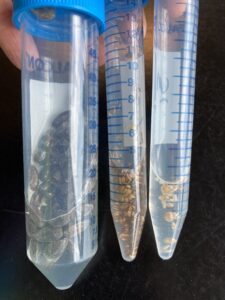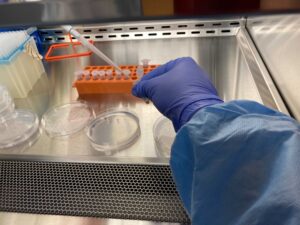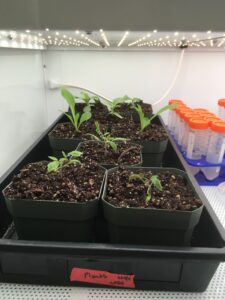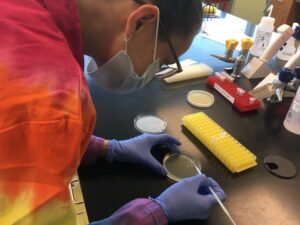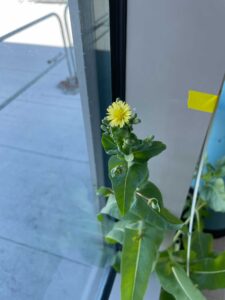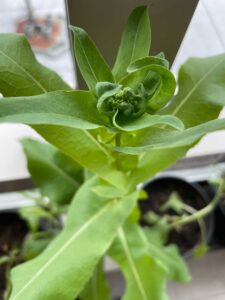Dr. Carly Sjogren
- B.A. Biology; University of California, Riverside
- Ph.D. Genetics, Genomics and Bioinformatics; University of California, Riverside
- Postdoctoral Research, Plant Stem Cell Development; University of North Carolina, Chapel Hill
- Education Postdoctoral Scholar, Biotechnology, North Carolina State University
Research Areas:
- Bioinformatics- genome alignments, de novo genome formation, genome annotations, transcriptome alignments, differential gene expression
- Data analysis: comparisons and relationships
- Plant development in crop species
- Molecular biology/crop genetic engineering
Techniques:
- Seed stratification & germination
- Plant upkeep
- Developmental and generational tracking
- Seed and tissue collection
- Plant DNA extraction
- DNA-sequencing
- Plant RNA extraction
- RNA-sequencing
- Library Prep
- Nanopore MinION sequencing
- Bioinformatics
- Data Analysis
Background:
Life on earth entirely depends on autotrophs, A.K.A. plants! Crop plants directly provide humans with the majority of our caloric intake, yet approximately 10% of the global population is food insecure. Hunger and malnutrition are the biggest risks to human health worldwide as 9 million people die of hunger annually, surpassing the death tolls of malaria, tuberculosis and AIDS combined.1 Agricultural yields must grow in parallel with the increasing global population, and overcome threats from climate change, industrial practices to meet consumer pressures as well as fallout from the 2019 global pandemic.2,3 The agricultural yields that we depend upon to feed humanity are a direct result of stem cell function in plants. Pluripotent cells in plants continuously proliferate throughout an entire life cycle to generate new organs like the roots, leaves, flowers and fruits we consume. The genetic mechanisms that regulate these processes must be better understood in order to increase crop production and assure global food security.
I have two research projects use Next Generation Sequencing Technologies that student researchers can choose to work on:
(1) Transcriptomic Project: The ultimate goal of this RNA-seq project is to identify relationships of gene networks that regulate stem cell development across multiple plant species resulting in desirable over proliferative traits. Student researchers will identify a crop species to grow, collect tissue for RNA extraction, and gain the bioinformatic skills to analyze RNA-seq data. Currently working with Arabidopsis thaliana, Helianthus annuus (Sunflower), Solanum lycopersicum (Tomato), and Lactuca sativa (Lettuce). New crop selections are limited by being: diploid, self-fertile, genome size under 5 megabases, and being able to grow in a lab growth chamber.
(2) de novo Genomes Project: The goal of this project is to increase the genetic diversity of sequenced plant genomes in order to better understand plant development and evolution. As we generate more plant genomes as resources for the plant biology research community, we will gain a better understanding of the evolutionary origins or traits that regulate development. Student researchers will select a North Carolina native or endangered plant, collect tissue for DNA extraction following wildlife conservation guidelines, and perform de novo genome assembly using our Nanopore MinION benchtop sequencer! This is a brand new project without previous data to build upon and with unfettered potential to create something brand new!
Research students who are interested in learning how to assemble and align genomes (DNA) or transcriptomes (RNA) sequence data using bioinformatic tools are in for an exciting summer of research! Please include in your application whether you have a preference to work on the Transcriptomic or de novo Genomes Projects, and if you have a species in mind please share! I do not expect student researchers to commit to a species, but I would be excited to hear your ideas! These exciting plant genetic discoveries can be applied to the development of genetically engineered crops that can help increase crop yields, combating food insecurity and improving the human condition.
References
1. FAO, IFAD, UNICEF, WFP and WHO. 2020. The State of Food Security and Nutrition in the World 2020. Transforming food systems for affordable healthy diets. Rome, FAO. https://doi.org/10.4060/ca9692en
2. Food and Agriculture Organization of the United Nations; Commission on Genetic Resources for Food and Agriculture; http://www.fao.org/assets/infographics/FAO-Infographic-CGRFA30-en.pdf
3. U.N. Warns Number Of People Starving To Death Could Double Amid Pandemic. https://www.npr.org/sections/coronavirus-live-updates/2020/05/05/850470436/u-n-warns-number-of-people-starving-to-death-could-double-amid-pandemic
